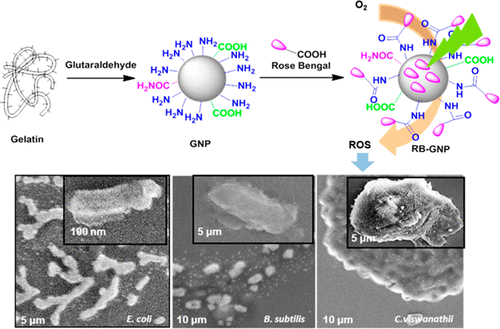当前位置:
X-MOL 学术
›
ACS Biomater. Sci. Eng.
›
论文详情
Our official English website, www.x-mol.net, welcomes your
feedback! (Note: you will need to create a separate account there.)
Development of Gelatin Nanoparticle-Based Biodegradable Phototheranostic Agents: Advanced System to Treat Infectious Diseases
ACS Biomaterials Science & Engineering ( IF 5.4 ) Pub Date : 2018-01-23 00:00:00 , DOI: 10.1021/acsbiomaterials.7b00751 Seema Kirar 1 , Neeraj S. Thakur 1 , Joydev K. Laha 1 , Jayeeta Bhaumik 1 , Uttam C. Banerjee 1
ACS Biomaterials Science & Engineering ( IF 5.4 ) Pub Date : 2018-01-23 00:00:00 , DOI: 10.1021/acsbiomaterials.7b00751 Seema Kirar 1 , Neeraj S. Thakur 1 , Joydev K. Laha 1 , Jayeeta Bhaumik 1 , Uttam C. Banerjee 1
Affiliation

|
Rose bengal (RB)-conjugated and -entrapped gelatin nanoparticle (GNP)-based biodegradable nanophototheranostic (Bd-NPT) agents have been developed for the efficient antimicrobial photodynamic therapy. The study reveals that the use of gelatin nanoparticles could bypass the chemicals such as potassium iodide, EDTA, calcium chloride and polymyxin nonapeptide for the penetration of drug into the cell membrane to achieve antimicrobial activity. We demonstrated that the singlet oxygen generated by the biodegradable gelatin nanoparticles (BdGNPs) could damage the microbial cell membrane and the cell dies. The key features of the successive development of this work include the environmentally benign amidation of RB with GNPs, which was so far unexplored, and the entrapment of RB into the gelatin nanoparticles (GNP). The RB-GNP exhibited potent and broad-spectrum antimicrobial activity and could be useful in treating multi-drug-resistant microbial infections.
中文翻译:

明胶纳米颗粒可生物降解的光热敏剂的开发:治疗传染病的先进系统。
已开发出基于玫瑰孟加拉(RB)结合和包裹的明胶纳米颗粒(GNP)的生物可降解纳米光热疗(Bd-NPT)试剂,用于有效的抗菌光动力疗法。研究表明,使用明胶纳米颗粒可以绕过碘化钾,EDTA,氯化钙和多粘菌素九肽等化学物质,使药物渗透进入细胞膜,从而达到抗菌活性。我们证明了可生物降解的明胶纳米粒子(BdGNPs)产生的单态氧可能会破坏微生物细胞膜和细胞死亡。这项工作的后续发展的关键特征包括RB与GNP的环境良性酰胺化(至今尚未开发),以及RB滞留在明胶纳米颗粒(GNP)中。
更新日期:2018-01-23
中文翻译:

明胶纳米颗粒可生物降解的光热敏剂的开发:治疗传染病的先进系统。
已开发出基于玫瑰孟加拉(RB)结合和包裹的明胶纳米颗粒(GNP)的生物可降解纳米光热疗(Bd-NPT)试剂,用于有效的抗菌光动力疗法。研究表明,使用明胶纳米颗粒可以绕过碘化钾,EDTA,氯化钙和多粘菌素九肽等化学物质,使药物渗透进入细胞膜,从而达到抗菌活性。我们证明了可生物降解的明胶纳米粒子(BdGNPs)产生的单态氧可能会破坏微生物细胞膜和细胞死亡。这项工作的后续发展的关键特征包括RB与GNP的环境良性酰胺化(至今尚未开发),以及RB滞留在明胶纳米颗粒(GNP)中。











































 京公网安备 11010802027423号
京公网安备 11010802027423号